
How to Relight a Water Heater’s Pilot Light
The information on this page should be considered secondary to the information in your water heater's instruction manual.
It’s vital that you read and follow all labels on your water heater and follow the safety instructions in the product manual before attempting any troubleshooting or repairs on your water heater. Doing so can help reduce the risk of property damage, serious injury or death.
What Is a Pilot Light?
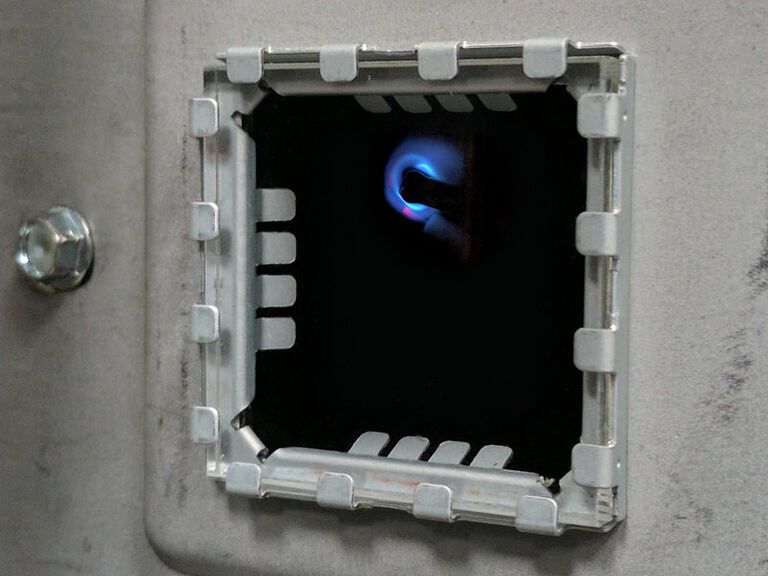
The pilot light on your water heater is the little blue flame used to light the gas streaming to your heater from the gas pipes coming from outside your home.
While some people believe that a water heater turns on when the pilot light ignites, traditional pilot lights are lit 24/7. The whooshing sound you hear when the heater kicks on is actually the unit’s valve releasing gas into the burner, where it’s then ignited by the awaiting flame.
How Does a Pilot Light Work?
The small flame that makes up a pilot light gets its fuel from a tiny stream of gas that enters the water heater through a small tube. The pilot stays lit around the clock, so it can burn up any additional gas released when the water heater turns on.
If the pilot light goes out, the thermocouple or thermopile will not be energized and the pilot safety valve will open. Gas will stop flowing to the pilot burner and the water heater shuts off. Electronic ignition systems protect against those risks by using built-in flame sensors to detect whether burners are lit before gas flows through the heater. If the burner doesn’t ignite automatically after several attempts, the heater can go into “lockout mode” to help prevent gas buildup.
Traditional/Manual
Traditional or standard pilot lights have flames that burn 24/7. When the water heater comes on, it draws in gas from your home’s gas lines and feeds it through piping to the pilot light. The gas ignites and helps heat the water in the unit’s tank.
While water heaters with a standard pilot light have been viewed as safe and reliable for decades, they do require routine maintenance and regular cleanings to stay functional and operate as safely as possible.
Electronic/Direct Spark
Electronic or direct spark pilot lights rely on an electrical current or a strike against conductive metal to come to life. In units with intermittent pilot lights, this process happens automatically when the water heater kicks on. Sometimes, electronically lit water heaters don’t have a pilot light at all. Instead, they use a hot surface igniter l that comes on when the heater needs to light, and then turns off when the main burner ignites.
Signs Your Pilot Light Is Out
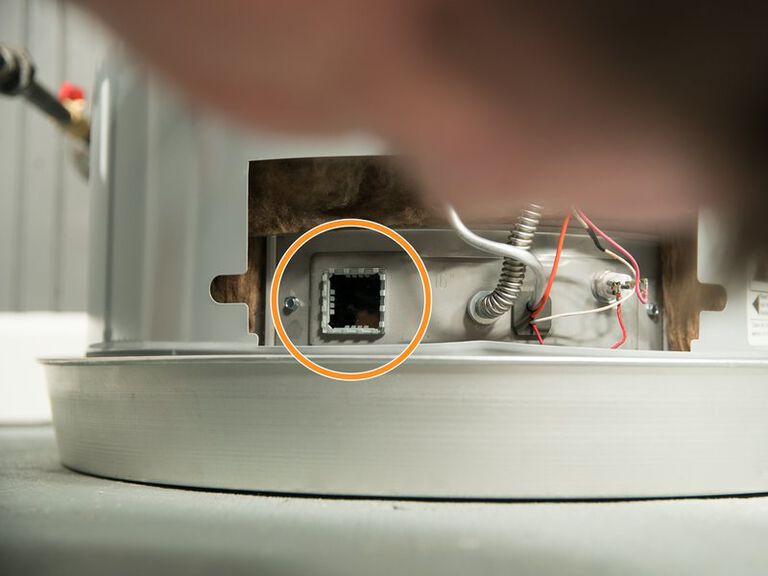
This image is only being used as example and may not reflect the specific unit or part that you may be troubleshooting.
Once you know the signs of a faulty water heater, it’s easy to get to the root of the problem of why your water heater pilot light keeps going out. If you encounter any of the issues below, it could be time to relight the pilot.
No Hot Water
If your pilot light won’t stay lit, your water heater won’t be able to warm up the water in the unit’s tank. If you go to take a shower and find yourself stuck under an icy cold deluge, that could be a sign your water heater isn’t performing as it should be.
Weak Flame or Lack of Visible Flame
A visual inspection can solve a lot of mysteries pretty quickly. Take a look at your water heater. Can you see the pilot light? Is there a visible flame? If so, your pilot light is still lit.
Why Is My Pilot Light Going Out?
There are several reasons a water heater pilot light keeps going out. Understanding the most common causes of pilot light issues can help you come up with a long-term solution, so you can fix your heater and enjoy hot water whenever the need arises.
Gas Pressure Changes
The pilot light on a water heater is susceptible to changes in gas pressure. In most cases, gas pressure will stay constant unless there’s some kind of interference. Even then, the pressure should revert to normal fairly quickly. Relighting your pilot could reset the system, but in some cases, gas pressure becomes an ongoing problem. This typically indicates an issue outside the water heater, perhaps with the external gas lines.
Problems With the Thermocouple/Thermopile
The main job of a water heater’s thermocouple/thermopile is to power the gas valve and shut down the flow of gas if the pilot light goes out. But if the thermocouple itself is broken, the pilot safety valve in the gas valve will not receive power, and the pilot will not remain lit once the pilot knob is released.
Drafts
When investigating a water heater pilot light that won’t stay lit, be on the lookout for drafts that could blow out the pilot light. Sometimes, an open door (if your water heater is in the garage or a utility room that opens to the outside) could be enough to allow a gust of wild to extinguish that small, somewhat fragile flame.
Lack of Combustible Air
Lighting a pilot light on a water heater requires a steady flow of air. If that airflow is limited due to the position of a newly installed water heater or something new blocking an existing unit, the pilot light could struggle to stay lit. For instance, imagine a water heater stuffed into a too-small closet or boxes of leftover yard sale goodies stacked up around the appliance.
Without enough air, it may be impossible for your water heater to properly burn off fuel. This issue can result in unburned fuel and/or carbon monoxide being released into your home. It’s a dangerous situation. If you suspect a lack of air is causing issues with your pilot light, it’s vital you bring in a tech to consult on moving your water heater or otherwise fixing the airflow issue before you tackle relighting the pilot.
Residual Gas in the Unit
One of the built-in safety systems in modern water heaters is a fail safe that prevents pilot lights from igniting if there is an air flow issue to the water heater.
This is the reason experts instruct homeowners to turn the gas off and let water heaters sit for at least 10 minutes before attempting to relight an extinguished pilot light. Those two steps — shutting off the gas and waiting — allow built-up gas to safely disperse, reducing the risk of an accident.
Ignition System Failure
Electronic ignition systems on gas water heaters are responsible for lighting the pilot light. If that system fails, there’s no fallback mechanism that can save the day. Contact a professional if you have issues with this system.
Clogged Pipes or Kinked Hoses and Tubes
Another possible reason your water heater’s pilot won’t light could be a kink or clog in the flex tubes linking your fuel supply and your gas controller. If those tubes aren’t fully open and operational, the pilot light can’t get the gas it needs to stay lit.
Control Valve Failure
Like any mechanical component integral to the operation of a machine or appliance, the pilot control valve in your water heater can fail over time. If this is the reason behind an extinguished pilot light, you’ll need to call for a service visit, and the valve will most likely need to be replaced.
Can I Relight a Pilot Light by Myself?
Most pilot lights can easily be relit at home by a homeowner or other resident, but learning how to relight a pilot light takes time, effort and self-confidence. You also may need to have a certain amount of mobility and flexibility to maneuver around the heater and reach units installed in smaller spaces. If you're unsure about tackling this task on your own, call a certified plumbing contractor to ensure the job is done safely and correctly
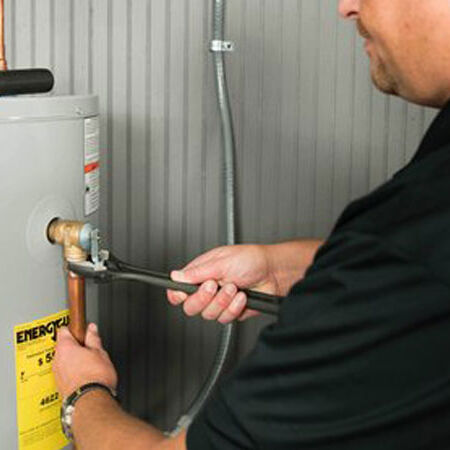
Find A Local Water Heater Pro
A. O. Smith water heaters are professionally installed by local independent contractors.
Relighting a Pilot Light
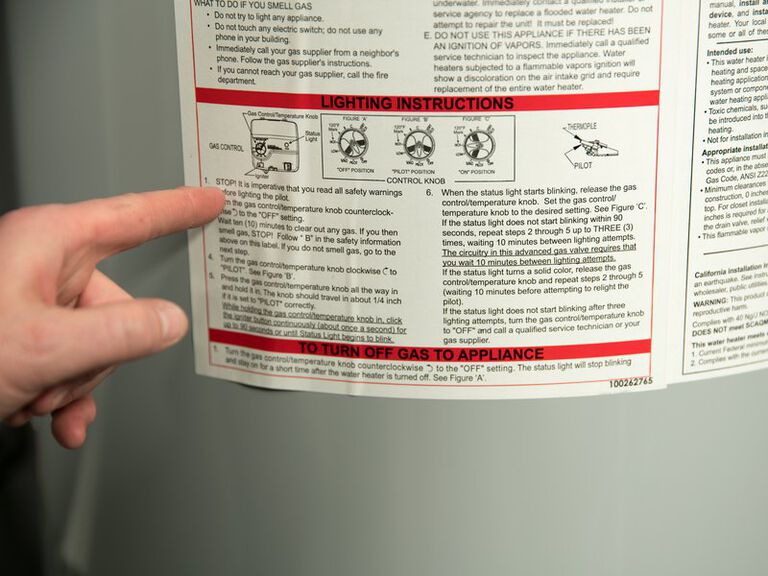
If this is your first time servicing your water heater on your own, or you need a refresher, be sure to read through this entire guide on how to light a pilot light.
Before You Begin: What You’ll Need
In most cases, you won’t need any specialized tools or supplies to execute the steps in this guide. However, before you learn how to light a pilot light on a water heater, you’ll want to make sure the area around the heater is free from debris and anything that might obstruct your movement or obscure your ability to see what you’re doing as you complete the steps below. Do not continue if you smell gas.
It may be helpful to have a flashlight handy, especially if your water heater is located in an area without a lot of natural or artificial light. Some pilot light access panels require a screwdriver to complete removal.
Before continuing, review the lighting instructions for your water heater as located on the water heater’s label and/or in the owner’s manual that came with your unit. These instructions supersede the instructions in this guide.
Search for support resources for your specific A. O. Smith model.
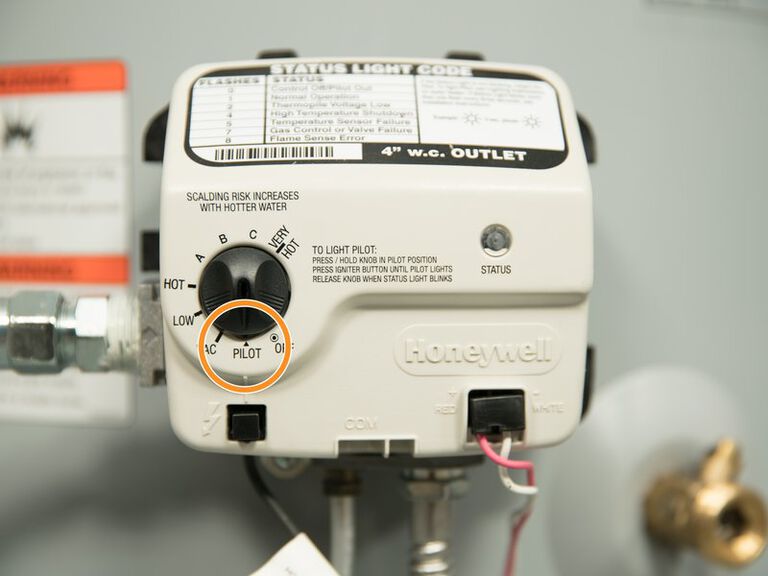
This image is only being used as example and may not reflect the specific unit or part that you may be troubleshooting.
Step 1: Locate the Pilot Light and Gas Control Knob
First, locate your hot water heater’s pilot knob. It’s usually located near the bottom of your water heater on the gas control valve as that control is integral to Step 2.
Step 2: Turn Off the Gas and Wait 10 Minutes for the Gas to Dissipate
Before you even touch your heater’s pilot light, you need to turn off the gas to the unit using the gas knob you located in Step 1. Wait at least 10 minutes to give any gas built up in the lines a chance to dissipate. This is a safety measure put in place to prevent explosions that could occur if you relight the pilot and accidentally ignite a pool of residual gas.
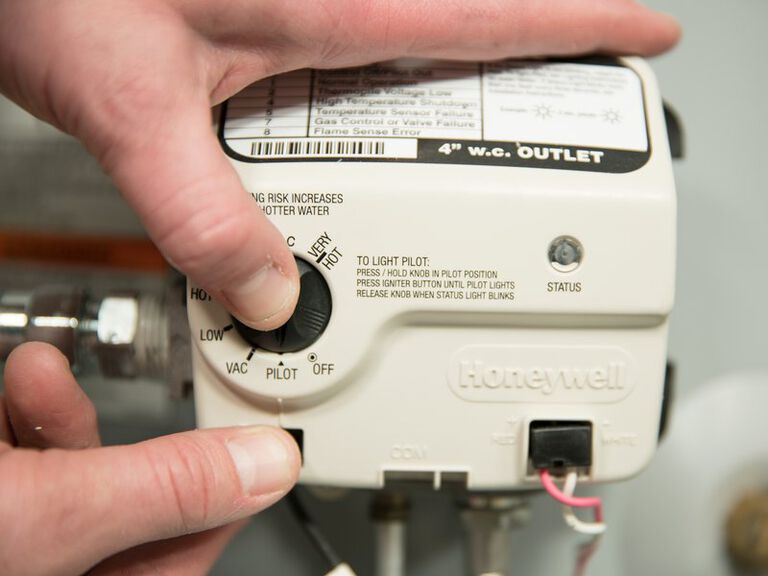
This image is only being used as example and may not reflect the specific unit or part that you may be troubleshooting.
Step 3: Set the Control Knob to Pilot
Ensure the gas control knob is set to “Pilot” and fully pushed in — when pressed, the knob should move in about ¼ inch.
Step 4: Lighting the Pilot
There are two ways to ignite your pilot light, depending on the type of water heater you have installed.
Electronic Lighting/Direct Spark
While holding the gas control knob, repeatedly press the ignite button until the flame stays lit.
While holding in the gas control knob, press the ignitor button (this is typically a square button and should be clearly labeled). Click the ignitor button about one time every second. You should hear it click. Press the ignitor button repeatedly for up to 90 seconds until the pilot lights or you get a flashing status light.
Important: The status light must flash once per second for the water heater to work. If the light on your unit is flashing, you have reached your goal.
If your water heater’s status light doesn’t flash after three attempts, look for the “Troubleshooting No Status Light” section in your owner’s manual and follow those instructions to further address the problem. You can find additional assistance via our general support resources or find support by model.

This image is only being used as example and may not reflect the specific unit or part that you may be troubleshooting.
Step 5: Turn the gas control knob back to the on position
Now that the pilot light is back on, slowly depress the gas control knob. Monitor the pilot light to make sure it stays lit even after the control knob is released.
You can then turn the gas control knob back to the on position or your preferred temperature.
Inspect the Flame/Check the Status Light to Make Sure It Stays Lit
Once everything is reset, give the flame one final look. Is it still lit? Is the flame large enough and steady? Also look at the status light. Remember, it should be flashing once per second. If it isn’t, your pilot light issues aren’t completely resolved.
If your pilot light refuses to cooperate, find a local service provider who can help with repairs. And if repairs fail, it may be time for a new unit. Search for professional installers near you and rest easy knowing your A. O. Smith water heater will be properly installed.
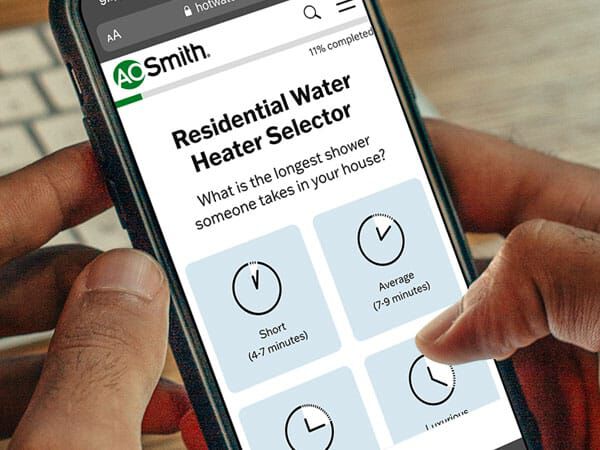
Not sure which product is right for you?
Use our water heater selector to find the correct water heater for your home.
Why A. O. Smith?

A. O. Smith is a leading manufacturer of both residential and commercial water heating technologies, including the #1 most specified commercial water heater.

For more than 145 years, we’ve developed state-of-the art products that push new boundaries and improve the lives of our customers.

We combine cutting-edge technology with committed people who take pride in providing the very best support for our customers.

Our products are put through rigorous quality and endurance testing so now matter where hot water is needed, A. O. Smith can provide a solution you can count on.